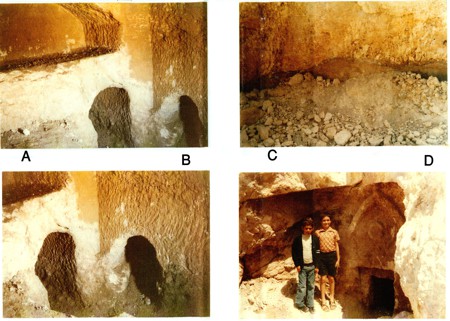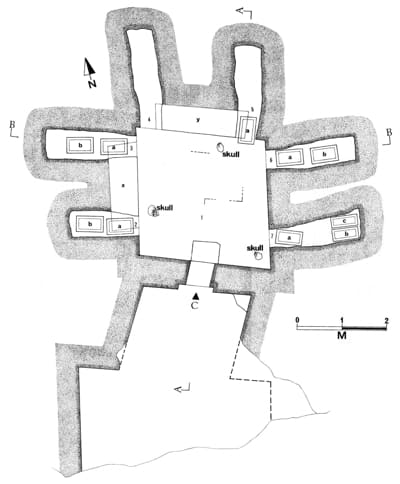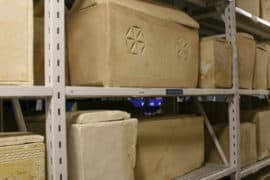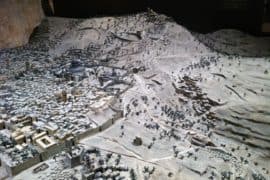In March, 2007, when all the publicity on the Talpiot Jesus tomb broke, I wrote a blog post that summarized what we knew at the time regarding the 1980 discovery and excavation of the “Jesus tomb,” and perhaps more important, what we did not know. It is still worth reading for comparison and contrast and you can find it here: The 1980 Discovery of the East Talpiot “Jesus Tomb”: What We Knew and Did Not Know in 2007.
Twelve years later we can say much more. In chapter one of our book, The Jesus Discovery, we summarize what we now know with extensive documentation in the footnotes. So far as I know our treatment supersedes anything that has been previously published. Our results are based on a meticulous examination of archive documents and photos from the Israel Antiquities Authority, all relevant publications, interviews with the archaeologists involved, as well as extensive discussions with the neighbors and Orthodox officials who visited the tomb on the first weekend, who provided us with additional photos. There have been a lot of contradictory accounts about the details but we have managed to sort thing out based on all the evidence taken together. Here is a summary of what we found. Our book contains extensive documentation, photos, and notes, including this never before published IAA close up of the Talpiot tomb facade, inside entrance, and the blown-away porch area, taken on Friday, the day after the blast:

The tomb was exposed by a dynamite blast by the Solel Boneh construction company on Thursday morning, March 27, 1980. It is located just off Dov Gruner Street in East Talpiot. Ironically it was just before Easter weekend with Passover falling on the following Monday evening. Engineer Ephraim Shohat, as well as his supervisor, immediately notified the Israel Department of Antiquities, as it was then known, who dispatched archaeologist Eliot Braun, who happened to live in the area, to investigate. The outside covered courtyard of the tomb had been completely blasted away, exposing an unusual façade with a chevron and a circle, carved on the face of the small inner entrance to the tomb itself. This entrance, measuring eighteen-by-eighteen inches, would have normally been covered with a sealing stone but it was missing, perhaps indicating the tomb had been left open or was disturbed at some time in the past. Braun crawled inside the tomb and found that it was filled knee deep with the local terra rosasoil that had apparently washed in over the centuries, covering the tops of the ten ossuaries, yet unseen, that were stored inside. The inside of the square tomb measured only nine-by-nine feet with the ceiling about four feet from the floor. He recalls that he could not even stand up inside. The Jesus tomb is a much more modest one than the Patio tomb 200 feet away, both in terms of size and the architecture of the niches, which are roughly cut. The Garden tomb’s interesting façade is its most distinguishing marker.
There were six burial niches or kokhim, measuring six feet deep, twenty-one inches wide, and thirty-four inches high, carved into the east, north, and west sides of the tomb, two per side, with ossuaries stored in five of them. The tomb had two arched shelves, called arcosolia, six feet in length, carved into the north and west sides of its walls. It was on these shelves that corpses would be initially laid out for decomposition before the bones were collected into ossuaries a year or so following death. Archaeologists later noted that there were bone fragments on the shelves and when the two feet of terra rosasoil fill was removed, exposing the ancient floor of the tomb, they found skeletal remains, including skulls and vertebrae, just below the two shelves, as if they had been swept off onto the floor by some ancient intruder.
District archaeologist Amos Kloner supervised the operation and he assigned Department of Antiquities archaeologist Joseph Gath to carry out the excavation. Gath invited Shimon Gibson, a young archaeology student with a talent for drawing to prepare a survey or map of the tomb. Kloner applied for the necessary license to excavate on Friday, March 28thwith Joseph Gath as the license holder. The “Permit for a Salvage Dig 938” was issued on Monday, March 31st, the day before Passover, but apparently, according to IAA files, Gath had begun his work with the aid of Braun and three or four construction workers on the Friday morning after the discovery. The excavation continued, with short breaks for the eight day Passover holiday, until Friday April 11th, two weeks later.
Around noon Friday, the day after the tomb was exposed, an eleven-year-old schoolboy, Ouriel Maoz, whose Orthodox Jewish family lived near the site, passed by and saw the distinctive façade of the exposed tomb, clearly visible from the street below. He ran home excitedly to tell his mother, Rivka Maoz, who immediately called the Department of Antiquities to report the newly visible tomb; concerned that if left unguarded its contents might be plundered. She could not get through to anyone since businessesclose early on Friday afternoon for the Jewish Sabbath. The mother and son then went together to the tomb as the light was fading and they remember that they could see some skulls and bones inside, as if things had been disturbed. They saw no signs of any archaeologists or workers on the scene.

The next day, Saturday, was the Sabbath.Ouriel remembers running home from synagogue to tell his mother that some local kids had entered the tomb, found the skulls and other bones, and were playing soccerwith them, kicking them about the area. The tomb had been left unguarded over the Sabbath. She and her husband ran the children off and gathered all the bones they could locate, going door-to-door asking parents to be sure they made their children return all the bones. They gathered all they could collect, putting them in plastic bags for safekeeping until the next morning. On Sunday morning, when the archaeologists arrived to continue their work, she delivered the bags of bones to Joseph Gath.

Shimon Gibson arrived about noon on Sunday.In 2003, when I first interviewed him about his arrival at the scene, he distinctly recalled seeing the ossuaries that had been removed from the tomb lined up outside, waiting for a truck from the IAA that would transport them to the Rockefeller Museum, where the IAA was headquartered. There they would be cleaned, photographed, and most important, examined for inscriptions. The skeletal remains inside the ossuaries could also be studied.Gibson recalled how Joseph Gath took him inside the tomb, where the workers were removing the soil that had accumulated, and he could still see the impressions left by the ossuaries. Gath indicated to him where each had been located so he could include their original locations of all ten on his map. If Gibson’s initial memory was correct that would mean the ossuaries were not removed until midday Sunday and had been left in the tomb Friday and Saturday. This would explain how the neighborhood kids were able to pull skulls out of the tomb for their makeshift soccer game since the ossuaries were buried under a foot-and-a-half of soil and not visible when the archaeologists first began their work.
Getting these chronological facts straight is critical in the case of the Garden Tomb. If the tomb was indeed left open and unattended with ossuaries inside from Thursday through Sunday morning,there is a real possibility that the tomb could have been looted and ossuaries removed.Might a passerby, or even a workman, have stolen anything from the tomb on the Friday and Saturday immediately following its discovery? The construction workers who exposed the tomb were certainly aware of it and by Saturday those living in the neighborhood know of the tomb as well.
The matter of the scattering of the bones is also troubling. How many bones were scattered and lost? Were the rest left in the ossuaries and taken to the IAA for analysis by an anthropologist, which would have been the normal procedure? What did Gath do with the bag of bones that the Maoz family gave to him Sunday morning? We don’t know the answers to any of these questions. It is quite chilling to think the bones from this ancient Jewish family, including the skulls from inside the ossuaries, were scattered and kicked about, when the tomb was left unguarded over that fateful weekend.
Joe Zias, the anthropologist at the Rockefeller who routinely received bones from tomb excavations says that he does not remember receiving bones from this particular tomb but he observes that construction crews were uncovering many dozens of tombs in the 1980s and there was no reason for any particular set of bones to receive any special treatment. Since Zias was the main “bone man” or anthropologist there at the time,it would seem that his lab would have gotten the skeletal materials but there is no record that he ever examined them or prepared a report. That is unfortunate since even a cursory examination would have contributed immensely to our know of the family that was buried in this tomb.
Typically at that time, ossuaries with the bones inside were transported to the laboratory intact where the bones could be separated for analysis and study. Depending on their state of deterioration they could be typed for age, sex, and any other distinguishing forensic information. This would also allow any potential correlation between the ossuary contents and ossuary inscriptions. One must assume that these and all other skeletal materials in various Israeli labs were turned over to the Orthodox religious authorities in 1994 when the Israeli government agreed to return such remains for reburial. The bones would have then been reburied in unmarked common graves by the Orthodox Jewish authorities.
Amos Kloner reports that he visited the tomb when it was first reported to the Antiquities authorities on Thursday, took photos, applied for the permit, and by noon Friday Gath and his workers had extracted all ten ossuaries from the niches, digging them out of the soil that filled the tomb. Kloner insists that all ten ossuaries, with their bones, were transported to the safekeeping of the Rockefeller Museum by midday, hours before the Sabbath arrived on Friday night. Kloner’s photos, now part of the official IAA files, do indeed show the niches in the tomb filled with soil to a level that made the ossuaries resting on the floor invisible. The IAA records show that Gath, Braun, and some workers had begun at least to clear the soil over the ossuaries on Friday morning. Various eyewitnesses, including Gibson in his original testimony, dispute whether Gath and his workers removed all ten ossuaries by noon that Friday for transport to the Rockefeller. It seems unlikely since several of the ossuaries were broken and extracting them all from their encasement in two feet of soil would have required considerable effort.
The Maoz family says they never saw any archaeologists working at the tomb on Friday afternoon when they first visited. That they saw skulls and bones exposed might indicate the archaeologists had reached the tops of the ossuaries that morning before suspending their work and shutting down for the Sabbath. The tomb was left unguarded, as it had been the previous Thursday afternoon and evening. This open tomb, with its striking façade, visible from a distance up on the ridge, was an invitation to local children or other intruders, to enter the tomb and ransack things Friday night. The presence of skulls is particularly noteworthy, since these skulls would have come from inside the ossuaries—indicating that at least the soil covering the tops of the ossuaries had been removed on Friday morning. Rivka Maoz gave us several color photos from the family album, two taken inside the tomb, showing that the ossuaries had been removed when the photos were taken. But that is the critical question—whenwere these photos made by the Maoz family? Kloner and Gibson insist they were made on March 29th, on the Sabbath, but that cannot be the case. The photos were definitely made sometime after Saturday since the Maoz family are observant Jews and are not permitted to take photographs on the Sabbath. They were most likely made late on Sunday since there are no workers in the photos and the ossuaries had already been removed. Shimon Gibson is now convinced that his initial memory was faulty and that when he arrived Sunday morning he must nothave seen the ossuaries outside after all, since they would have been taken away by the archaeologists by noon on Friday according to Amos Kloner. Everyone has the right to revise their recollections and change their mind, but Gibson does have a near photographic memory and in his initial interviews with us he was quite explicit about seeing them all outside.
According to all the records the Garden tomb contained a total of ten ossuaries,and they were catalogued as numbers 80.500 through 80.509 in the IAA collection. The current card catalogue at the IAA warehouse in Beth Shemesh only lists nine; the tenth, numbered 80.509, is not included, nor are there any photographs or measurements of it in the IAA excavation files. It is nowhere to be found though there are various possibilities as to its subsequent fate.
Gibson’s drawing shows all ten ossuaries in place in five of the six niches, marked with a number and a letter. Unfortunately Kloner reports that he can find no record that would match up the ossuaries and their catalogue numbers with their original locations in the tomb on Gibson’s map. That sort of information, correlating finds with their location at an excavation site, is basic Archaeology 101 for any archaeological fieldwork. Recording precisely wherethings were found is perhaps the most important aspect of any excavation, as every beginning student of archaeology knows. It seems impossible to imagine that Joseph Gath failed to tag the ossuaries with locus numbers. No one would send a group of ten ossuaries to the Rockefeller, or any artifact for that matter, without filling out a proper identification tag. The loss of that information is most unfortunate. Six of the nine ossuaries were inscribed with names and if we had their original locations one would be able to know how the names were grouped in the tomb, giving possible hints as to the relationship of the individuals buried there to one another.
The six inscriptions, the one in Greek and the rest in Aramaic are, in English: Jesus son of Joseph, Mariamene/Mara, Joses, Judah son of Jesus, Matthew, and Mary. Since we clearly have a father named Jesus and his son Judah in this tomb, one wonders which of the named women, Mariamene called Mara or Mary, might have been the mother? One might expect that the ossuaries of the father, mother, and son would be grouped together in the same niche. There is one niche, just on the right as you enter the tomb, that, according to Gibson’s drawing, held three ossuaries, clustered together. It is tempting to imagine that the Jesus of this tomb, his son Judah, and the mother might be clustered together in this place of honor—first on the right as you enter the tomb. Unfortunately, given the lack of proper records we now have no way of knowing.
At the time the ossuaries were removed and taken to the Rockefeller Museum the archaeologists noticed that some of the ossuaries were inscribed in Greek and Aramaic but the name “Jesus son of Joseph,” that might have at least raised an eyebrow or two, is quite difficult to read as it is written in a informal cursive style. In due time Israeli epigrapher Levi Rahmani, along with Joseph Naveh and Leah Di Segni, deciphered the names, but how long after the tomb’s discovery we do not know. The nine ossuaries with descriptions and photos were included in the official Catalogue of Jewish Ossuariesin 1994, authored by Rahmani. This volume surveys 897 ossuaries that were in the collections of the State of Israel in 1994—227 with inscriptions. The publication of Rahmani’s catalogue was the first time these six names from the Garden tomb, saw the light of day—fourteen years after their discovery.









Comments are closed.